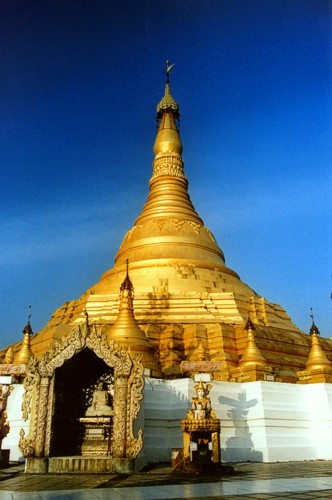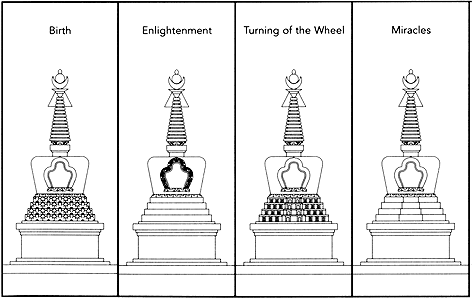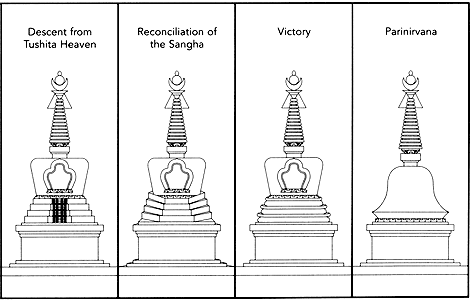An excerpt from a teaching called Cosmology of a Stupa by Tulku Sang-ngag Rinpoche
Stupas can be roughly divided into two categories – Theravada or Hinayana stupas, and stupas in the Mahayana tradition. There are further subdivisions of those stupas, with different shapes and designs.
In the Hinayana tradition, there are stupas that are roughly in the shape of the Buddha’s body, some in the shape of his robes, some in the shape of his alms or begging bowl, and some in the shape of his throne or in the shape of a staff. There are different renditions.

In the Mahayana tradition, there are eight principle stupas. At the time after the Buddha was cremated, his relics were divided into eight piles and given to eight different great kings who made stupas for those relics. According to the great teacher, Nagarjuna, there are eight principle stupas that perform eight different functions.
These eight principle stupas in the Mahayana tradition commemorate the great deeds of the Buddha’s life, from the time when he was born till his passing into nirvana. For example, there is a stupa that commemorates his birth, that moment just after his birth when he took seven steps in the four directions. Each time he took a step, a lotus flower blossomed under his foot. And so, there is a stupa that commemorates the birth of the Buddha.


There is a stupa that commemorates the fact that the Buddha studied a whole variety of topics in his youth and mastered them all. There is another stupa called the auspicious many-gated stupa. The Tashi Gomang stupa celebrates the fact that the Buddha descended back down from Tushita Pure Land, where he was teaching his mother.
In the Vajrayana tradition, the tantric vehicle, there are specific stupas that accomplish particular purposes. For example, there are the four main types of stupas for pacification. Some are to magnetize. Some are to increase, increase prosperity and merit, and others are for more wrathful activities. There are different shapes that the stupa can adopt, but the fundamental meaning is the same – stupas represent the enlightened body, speech and mind of the Buddha. The stupa primarily represents the enlightened mind of the Buddha.










